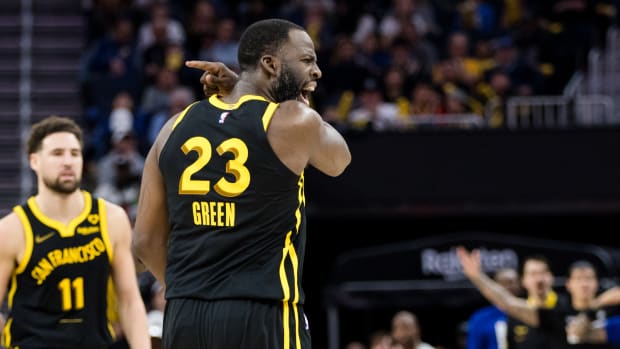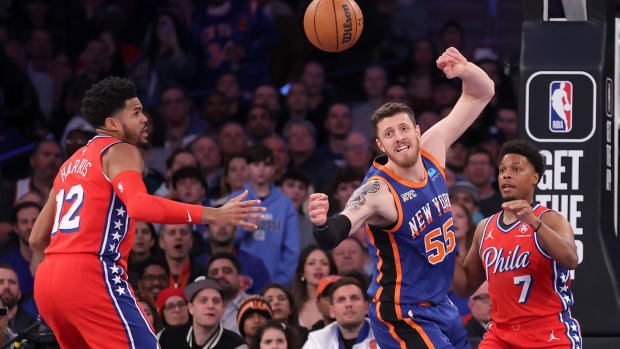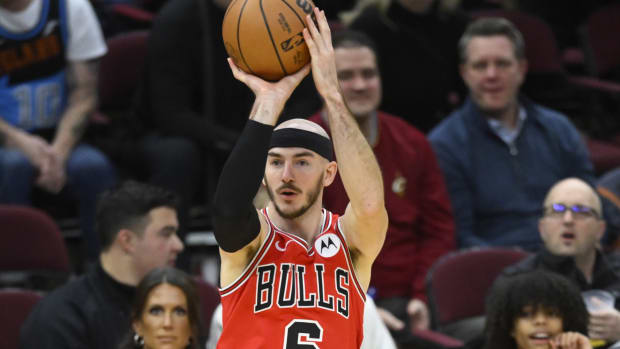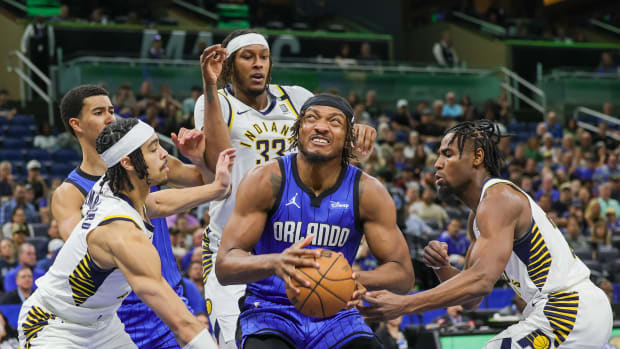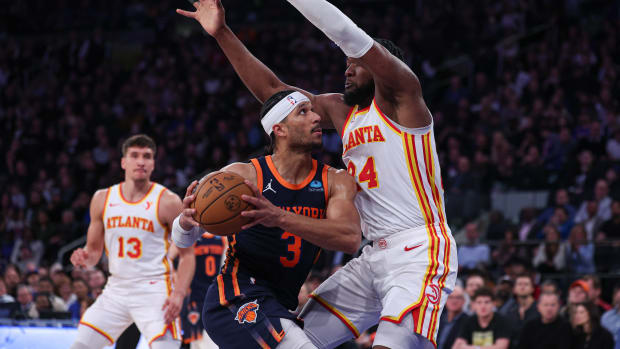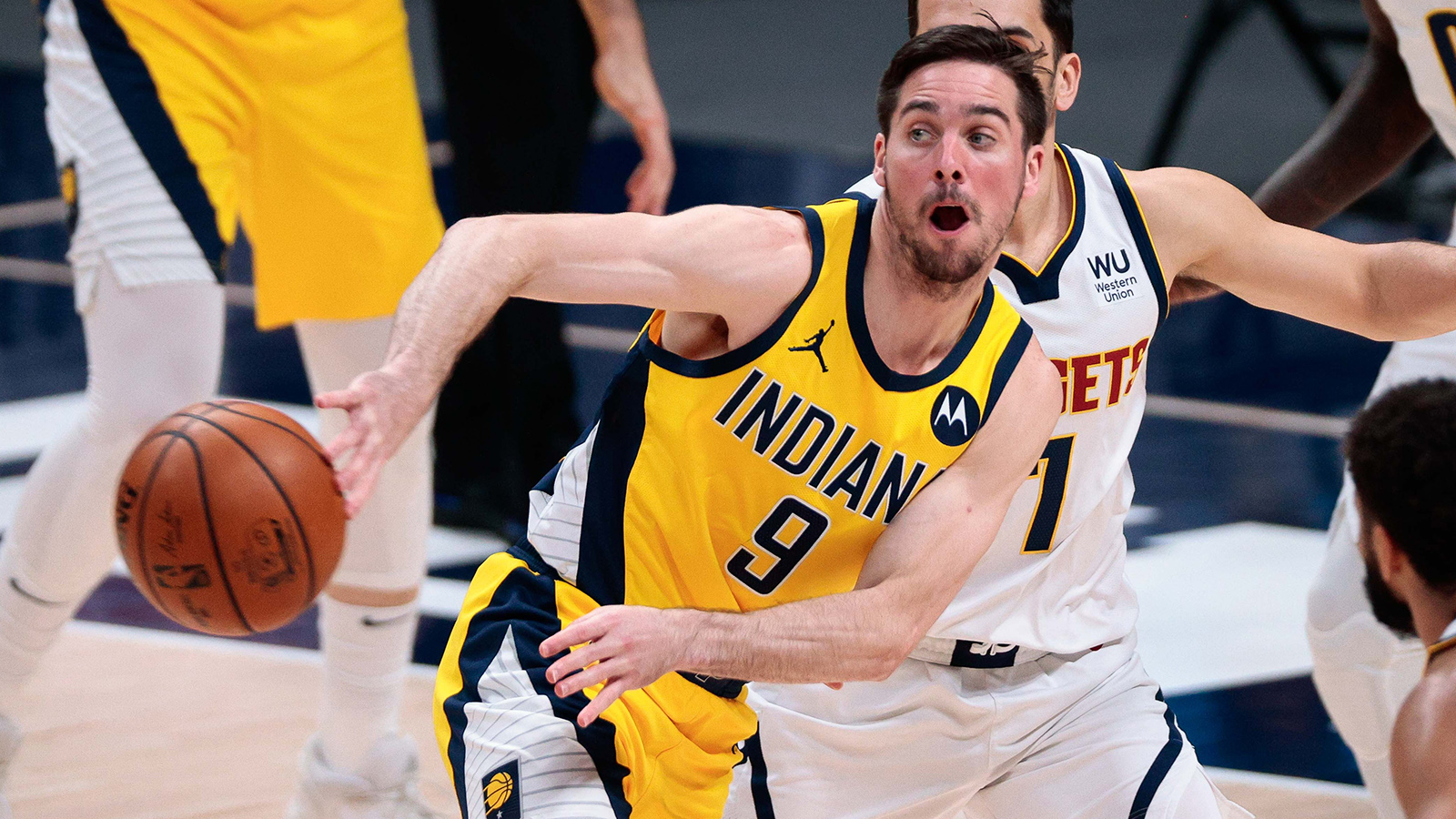
T.J. McConnell Is Here to Stay
Welcome to the Morning Shootaround, where every weekday you’ll get a fresh, topical column from one of SI.com’s NBA writers: Howard Beck on Mondays, Chris Mannix on Tuesdays, Michael Pina on Wednesdays, Chris Herring on Thursdays and Rohan Nadkarni on Fridays.
In theory, Pacers point guard T.J. McConnell has very little in common with panthers, lions or tigers.
Where big cats are obligate carnivores, who only digest meat, McConnell’s incorporated vegan elements into his diet since reaching the NBA. Where big cats are physically imposing, McConnell—at 6' 1", with some of the smallest hands and one of the smaller wingspans in recent NBA memory—is not.
But there is at least one shared trait: Much like those animals, McConnell is most likely to pounce when opponents least expect it, as their backs are turned. By the time they realize what’s happening, it’s too late.
This is the mindset for the Indiana point guard, who has been an elite backcourt burglar for years now.
Despite coming off the bench and playing just 26 minutes per contest, the 29-year-old leads the NBA in steals, partly because of his consistent ability to capitalize off of other teams’ thoughtless inbound passes. Since joining the league in 2015, McConnell’s logged 131 of these “backcourt steals,” defined as ones taking place within five seconds of a change of possession. That comes out to one such steal every 72 minutes, giving him the highest rate of any player these past five-plus seasons, according to Stats Perform.
Most Steals Within Five Seconds of a Change of Possession, Per 36 Mins Played
| Player | STL | Minutes Played | STL Per 36 |
|---|---|---|---|
T.J. McConnell | 131 | 9604 | .491 |
113 | 9046 | .450 | |
Tyus Jones | 71 | 6653 | .384 |
Lonzo Ball | 68 | 6575 | .372 |
Delon Wright | 68 | 6678 | .367 |
In a way, McConnell’s quick-strike pilfering prowess is fitting: Almost no one saw him carving out the career he has for himself these past few years. As an undrafted player, he already faced long odds in terms of having an extended stay in the league. (Since the association moved to its modern, two-round format in 1989, just under 40% of undrafted players have managed to make it to Year 3, per Stats Perform.) The early days of that “process,” with Philadelphia, were exceedingly rough for McConnell. After one home game, he walked over to a restaurant near the Sixers’ arena that allowed free entry for fans who had ticket stubs from that night’s contest. As McConnell walked up, the host demanded he pay the $10 cover.
“You don’t understand,” McConnell’s father, Tim, told the host. “He played in the game.”
McConnell, all of 5' 8" as a high-school freshman, has never been one to stand out physically. After offering him a scholarship, Ron Everhart, the man who’d go on to coach McConnell at Duquense, said he got a less-than-enthused email from a fan asking him, “Since when did we start recruiting waterboys?”
But even if the sixth-year guard’s stature doesn’t set him apart, his work ethic certainly does.
As grating as it is to hear about a certain type of basketball player personifying grit—and as annoyingly disproportionate as announcers can be with their praise for such players—the Pacers’ point man actually appears deserving of the description for a change. Hell, there are an array of advanced stats to prove it.
Along with leading the league in steals, McConnell flies around at 4.36 mph on the defensive end—the NBA’s fastest average speed, according to data from Second Spectrum. And it’s no surprise that the floor-burned floor general wore a huge bandage on his right knee earlier this week. He regularly dives and collapses onto the hardwood, where he’s recovered more loose balls per 36 minutes than any other player.
For a statewide market that loves its home-spun sports tales—both Hoosiers and Rudy were based on Indiana sports happenings—McConnell’s style of play fits right in. His motor never seems to shut off, whether he’s just entered the game in the first quarter, or up by 24 points in the closing minutes of a game.
“I really don’t know how to turn it off. I’m just really competitive,” McConnell says, adding that he sees how going for stealth, backcourt steals late, while up three touchdowns and a field goal, “might look bad.”
But dating back to high school, when he played for his father and his team used a full-court press, McConnell’s sought to force opponents into miscues. He hounds ballhandlers. As he sees opponents preparing to throw passes, McConnell leaps as high as he can, in hopes of making a deflection that can lead to a run-out. Sometimes, he almost looks like he’s trying to play the role of two defenders at once.
Years later, he can still hear the voice of Sixers development coach Chris Babcock, who told him during his rookie season, “You need to do stuff that other people won’t do” to stick at this level. That starts with staying in marathon shape. And, apparently, it means playing basketball like a scolding parent. With each underhanded steal and momentum-changing hustle play, McConnell is essentially saying: If you leave your things out and show you don’t respect them, I’ll gladly take them away from you.
Nearly every time, without fail, the inbounder’s shoulders slump after seeing the blur of McConnell come away with a steal—almost as if he draws his energy by siphoning out the opponent’s on plays like these.
While he checks off all the boxes to be a favorite among the Indiana fans, McConnell has one clear shortcoming. As a 33.4% career shooter from three, he’s improved, but is still a hair under league average. Opposing defenses all but dare him to shoot. Among guards, only Russell Westbrook sees defenders duck under pick-and-roll screens more frequently than McConnell does, according to Synergy Sports. It’s quite understandable why they don’t worry about him shooting all that much: McConnell has a usage rate of just 14.7%, his lowest in three seasons, even as his efficiency numbers have reached new heights.
Yet it feels wrong to nitpick at the things an undrafted player like McConnell doesn’t do. He’s already surpassed everyone’s wildest hopes and expectations by turning into a mainstay. Beyond that, McConnell is in the midst of the best season of his career, illustrating that he’s more than just a gritty hustle player.
Believe it or not, he is outperforming Chris Paul—one of McConnell’s inspirations, and long one of the NBA’s most dominant in-between players—from the paint and midrange so far. His 57.8% mark from inside the paint ranks third, and his 56.1% from midrange ranks best in the league among those who’ve taken 50 attempts from those areas. He’s shot 80% or better on five attempts or more in six different games this season—four times in the last week and a half alone—including a three-point win over Cleveland, in which he logged a triple-double by going 8 for 8 with 16 points, 13 dimes and 10 steals.
His passing—at 6.5 assists per game and an elite assist-to-turnover ratio—is vastly underrated, especially given that defenses are looking for him to pass the ball elsewhere. Because of that, McConnell treats his offense much like his defense, basically just taking what opposing clubs give him. But he also befuddles them by raising up for sidewinder jumpers after probing into the paint along the baseline. “Most of the time, I feel like teams don’t really know when I’m gonna shoot when I get in there,” the guard says.
At this point, McConnell has essentially made it. He plays sixth man–level minutes for a fringe playoff club, while logging efficiency numbers that jump off the page, despite his struggles from deep.
But when you start on the outside, like McConnell did—undrafted, and unable to escape the cover charge at the nearby restaurant without a Sixers’ ticket stub—you don’t forget what helped you find your footing. For McConnell, that means keeping his foot on the gas. Even if it looks borderline maniacal at times. It’s what got him here. And even as McConnell thrives, he’s convinced every possession is a job interview.
“I signed a four-year, nonguaranteed deal in Philly, where every year was nonguaranteed. It was stressful,” he says. “So I can’t get complacent and say, ‘I’ve got a guaranteed contract now, and I can relax.’ The moment I tell myself that, I probably need to hang it up and retire. I don’t have room to be complacent.”
More Morning Shootaround:






























